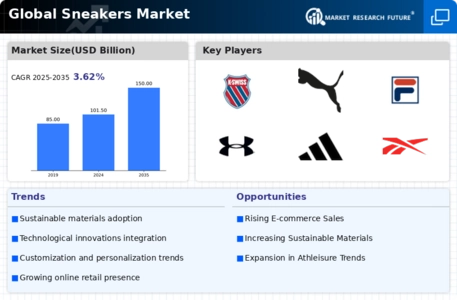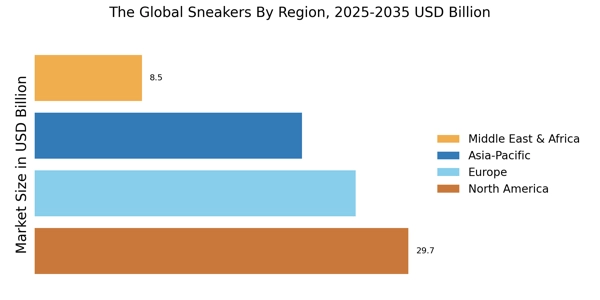Rising Health Consciousness
The increasing awareness of health and fitness among consumers appears to be a pivotal driver for The Global Sneakers Industry. As individuals prioritize physical activity, the demand for athletic footwear has surged. Reports indicate that the sports footwear segment is projected to grow at a compound annual growth rate of approximately 6.5% over the next five years. This trend is likely fueled by a growing inclination towards active lifestyles, with more people engaging in running, gym workouts, and outdoor activities. Consequently, brands are innovating to offer sneakers that not only provide comfort but also enhance performance. This focus on health and fitness is reshaping consumer preferences, leading to a robust market for sneakers designed for various athletic pursuits.
Fashion and Lifestyle Trends
The intersection of fashion and functionality is increasingly influencing The Global Sneakers Industry. Sneakers Market have transcended their traditional role as athletic footwear, evolving into a fashion statement embraced by diverse demographics. The rise of athleisure, characterized by the blending of athletic and casual wear, has propelled sneaker sales. Market data suggests that the lifestyle segment of the sneaker market is expected to witness a growth rate of around 7% annually. This trend is particularly evident among younger consumers who prioritize style alongside comfort. Collaborations between sneaker brands and high-fashion designers further amplify this trend, creating limited-edition releases that generate significant consumer interest. As a result, the market is witnessing a shift where sneakers are not merely functional but are also integral to personal expression and identity.
Increased Online Retail Penetration
The expansion of e-commerce platforms is transforming The Global Sneakers Industry, providing consumers with unprecedented access to a wide array of products. The convenience of online shopping, coupled with the ability to compare prices and read reviews, has led to a notable shift in purchasing behavior. Data indicates that online sales of footwear are expected to account for over 30% of total sales in the coming years. This trend is particularly pronounced among younger consumers who favor digital shopping experiences. Brands are increasingly investing in their online presence, optimizing websites for mobile use, and utilizing social media for marketing. This shift not only broadens market reach but also allows for personalized shopping experiences, thereby enhancing customer engagement and loyalty.
Sustainability and Ethical Production
The growing emphasis on sustainability is becoming a defining characteristic of The Global Sneakers Industry. Consumers are increasingly seeking products that align with their values, particularly regarding environmental impact. Brands that adopt sustainable practices, such as using recycled materials and ethical labor, are likely to resonate more with eco-conscious consumers. Market Research Future suggests that the demand for sustainable sneakers is projected to grow at a rate of approximately 9% annually. This trend is prompting companies to innovate in their production processes, aiming to reduce carbon footprints and promote circular economy principles. As sustainability becomes a key differentiator, brands that successfully communicate their commitment to ethical practices may gain a competitive edge in a crowded marketplace.
Technological Advancements in Footwear
Technological innovation is a crucial driver shaping The Global Sneakers Industry. Advances in materials and manufacturing processes have led to the development of high-performance sneakers that cater to specific athletic needs. Features such as enhanced cushioning, breathability, and lightweight designs are becoming standard expectations among consumers. The integration of smart technology, such as fitness tracking and adaptive fit systems, is also gaining traction. Market analysis indicates that the segment of technologically advanced sneakers is likely to expand significantly, with projections suggesting a growth rate of approximately 8% over the next few years. This emphasis on technology not only enhances user experience but also positions brands as leaders in a competitive market, appealing to tech-savvy consumers who seek both performance and innovation.


















Leave a Comment